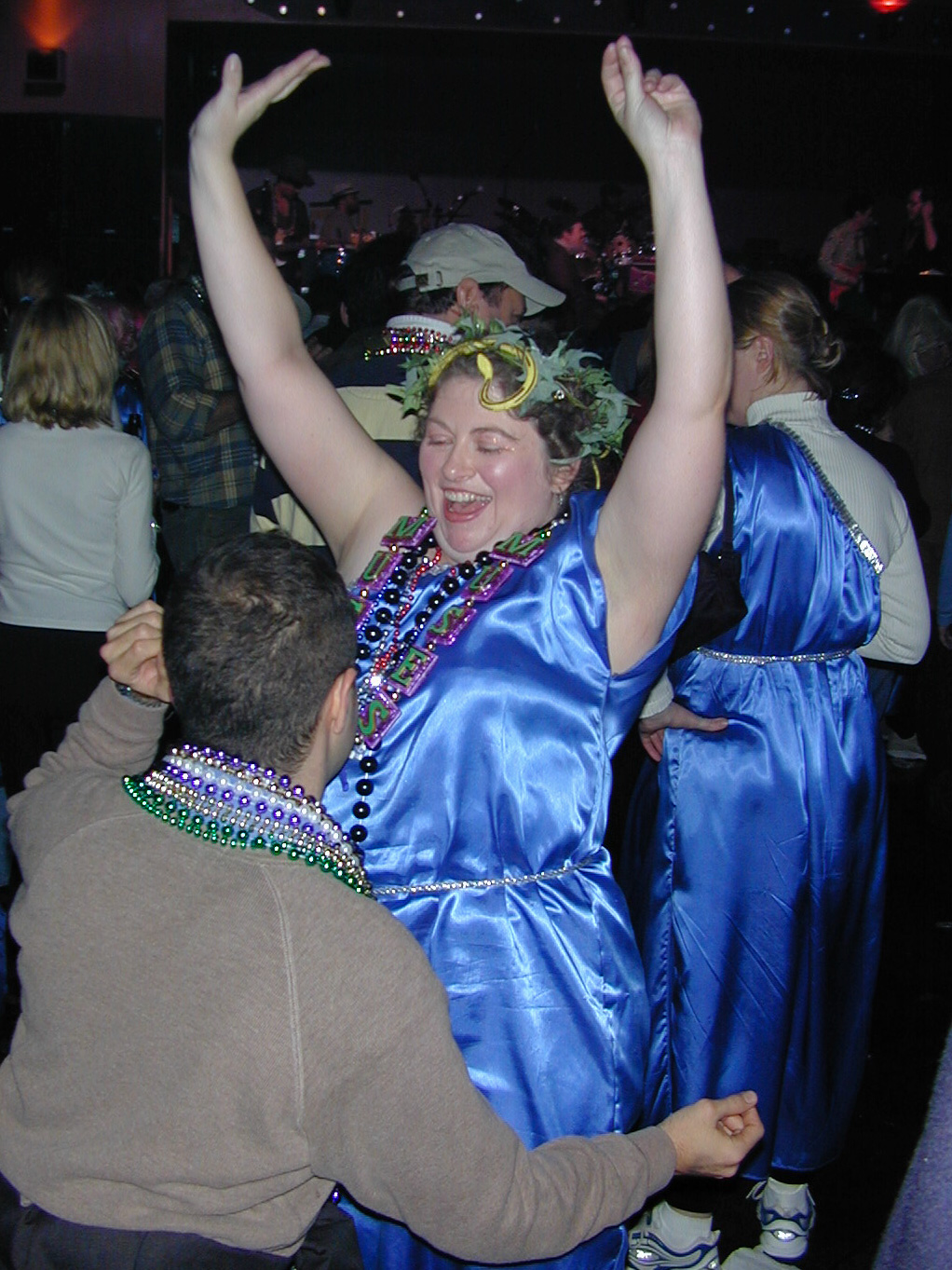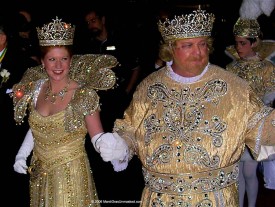While “society” Carnival balls are private affairs for krewe members and their invited, formally attired guests, some fêtes — including post-parade “extravaganzas” staged by the likes of Endymion, Bacchus, Orpheus and Tucks — are accessible to non-members. Costuming or fancy dress, drinking and dancing, live music, frivolity and pretend royalty are all key ingredients in the common quest to let pleasure rule.
Abundant but not always accessible
Revels come in many guises during the season of merriment that begins on feast of the Epiphany (Jan. 6) — the twelfth day of Christmas, the day the gift-bearing wise men visited the Christ child — and culminates on Mardi Gras (Fat Tuesday). They range from exclusive society balls to post-parade “extravaganzas” with thousands of attendees and big-name entertainment; from barroom “throw-downs” to just about any gathering during the Carnival season with familiar ingredients: a theme, costuming/fancy dressing and pretend monarchs presiding over “royal” courts, along with music, drinking, dancing and king cake. And, of course, beads and other festive paraphernalia. (In local parlance, “throw down” is both a noun and a verb: i.e., an occasion where people throw down, that is, cut loose, frolic and make merry.)
The 2006 Queen of Carnival (Charlotte Favrot Smallpage) and her consort, His Majesty Rex (Paul McIlhenny)
High-society Carnival balls are exclusive, invitation-only affairs that involve traditional rituals and codes of behavior that hark back Europe’s ancien régime.
High-society balls involve rituals and protocols that hark back Europe’s pre-Enlightenment, tradition-bound ancien régime. In the 19th century, especially after the Civil War, members of elite Carnival organizations — seeking to evoke a world of romance and chivalry as a tonic for the social and political upheaval of Reconstruction — began acting out aristocratic fantasies by carrying on in the style of the royal courts and palaces of Old Europe. They staged parades that ended in theaters and ballrooms, where krewe members would present a series of tableaux based on the theme of their parades. Tableau balls, including those staged by non-parading organizations, came to be known as “Carnival Balls,” where debutante queens and maids were presented. While these thematic revivals of monarchic rule still serve as affirmations of the city’s social register, at least for so-called “old-line” krewes, virtually all krewes retain some elements of the traditional rituals, although in widely varying degrees of formality.
Although society Carnival balls are typically private affairs for krewe members and their invited, formally attired guests, many parties and festivities are open to the public. Two of the biggest are free to attend, require no fancy dress and present live music: The Zulu Lundi Gras Festival and the Riverwalk Outlets’ Lundi Gras celebration, both taking place the day before Fat Tuesday.
Other major throw-downs occurring annually charge admission, e.g., the Bacchus Bash (not to be confused with the Krewe of Bacchus’s post-parade Rendezvous extravaganza), Krewe of Orpheus’s Orpheuscapade and Krewe of Freret’s Shorty Gras. There are many other options, including French Quarter balcony parties and more intimate gatherings. Check Eventbrite and WWOZ’s Community Events calendar for listings.
For a glimpse of the pomp and pageantry of society Mardi Gras, tune into WYES-TV/Channel 12 on Mardi Gras night, at 7 p.m., for the Meeting of the Courts featuring the Rex Organization and the Mistick Krewe of Comus. (Rebroadcast at 11:30 p.m. Streaming options.) In the evening’s finale, in a blaze of glittering rhinestones and brilliants, the krewes’ monarchs escort each other’s queens in a grand march around the ballroom. In its precise decorum and scripted formality, the spectacle is about as far removed from the free-for-all on Bourbon Street as one could possibly imagine.

Cuttin’ loose at the 2002 Krewe of Muses post-parade party
At Mardi Gras krewe celebrations, the dress code and style of revelry tends to reflect the ethos of the krewe itself.
While visitors to Mardi Gras won’t likely have the opportunity to attend the likes of a Comus or Rex ball, many krewe soirées are accessible to non-members who know or have a connection to a member. Generally speaking, the style of revelry and dress requirements reflect the heritage and ethos of the organization itself. Some large krewes, such as Orpheus and Endymion, sell admits to their extravaganzas — raucous post-parade parties that take place at the Convention Center and Superdome, respectively. The parades literally roll in from the street as float riders bombard the attendees with beads and other goodies. Attire is typically black tie and floor-length dress, with entertainment by local and national musical acts. There’s table seating, and you can bring your own food and liquor. “Set-ups” may be provided: soft drinks, tonic, soda, cups and ice. It’s best to purchase admits in advance. Admission to the Orpheuscapade is $225 in advance, versus $250 at the door. A table of 10 at the Zulu Social Aid and Pleasure Club’s formal-dress Coronation Ball, always held on the Friday before Mardi Gras, runs $2,500 (admits are not sold individually).
Tickets to larger galas, such as the Orpheuscapade, Endymion Extravaganza, Bacchus Rendezvous and Krewe of Tucks Extravaganza, sometimes turn up on Craig’s List and eBay. (Buyer beware: scammers often sell fake or non-existent concert tickets on Craig’s List.) Also note that some krewes, while not selling admission to their celebrations to the general public, offer a type of membership that entitles one to purchase admission. So-called “non-riding memberships” include benefits not directly associated with riding on a parade float. Typically, non-riding members are invited to all krewe events and pay the same fees to attend those events as riding members pay.
MardiGrasTraditions.com

